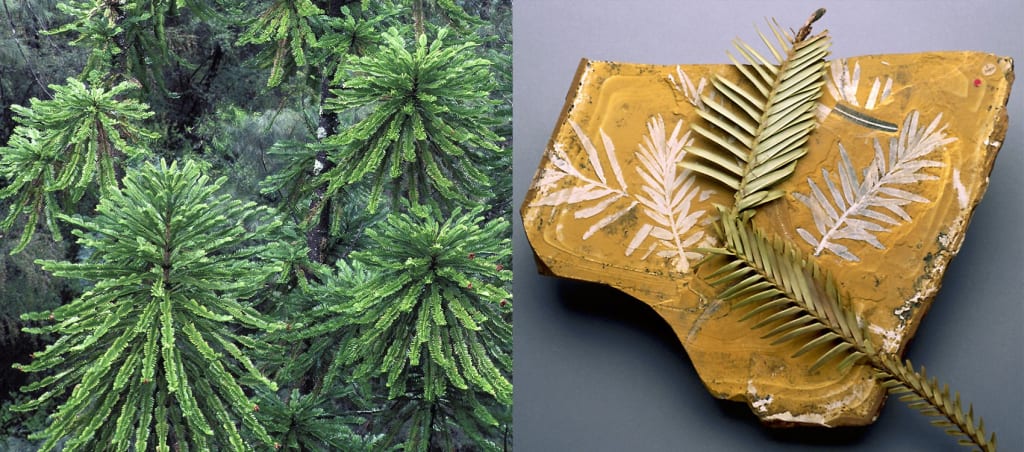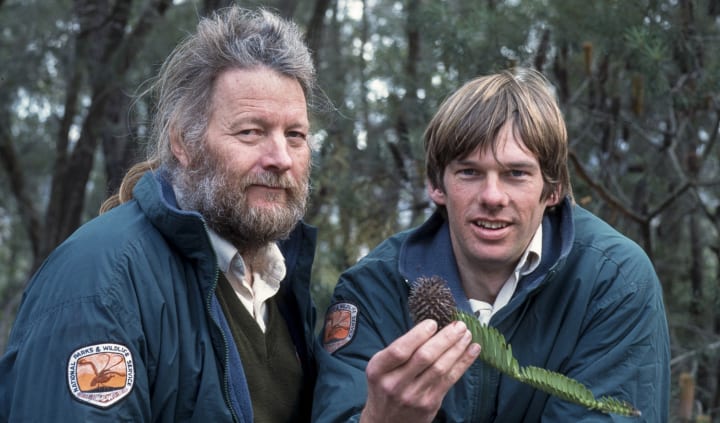Back From Extinction: The ‘Jurassic Pines’
They should have died out with the dinosaurs, but their seedlings are now being nurtured back from oblivion.

IT HAS BEEN CALLED the botanical find of a century: a lonely stand of conifers, the last of their kind and thought to have been extinct for aeons — until three bushwalkers came across them one sunny winter afternoon.
The 23 odd-looking pines, stretching up to 40 metres through the canopy of a deep and inaccessible gorge in Australia’s Wollemi National Park, are from a group that once covered the southern supercontinent of Gondwana.
Now known as ‘Wollemi Pines’, the trees were thought to have disappeared long before humans walked the Earth — until David Noble and his companions stumbled upon them. “They just looked a bit out of the ordinary,” says Nobel. “So I popped a cutting in my pack and took it back home to try and identify it.”
Back at his Blue Mountains home west of Sydney, the keen canyoner and student of botany were unable to match the sample with anything in the textbooks, so he later showed it to Wyn Jones, a colleague at the National Parks and Wildlife Service. Jones has spent most of his life studying rare plants of the Blue Mountains. “I thought that it was just a fern,” he says recalling that morning in August 1994. “Until Noble said, ‘It’s a bloody great tree!’. And that sort of shocked me.”
A month later the two retraced Nobel’s original route back to the site to collect more specimens. This was no easy task: the Wollemi National Park is a sandstone massif covered in eucalyptus woodland and scrub, peppered with isolated patches of rainforest.
Its 496,000 hectares are criss-crossed with hundreds of densely vegetated canyons ranging from a few metres to many hundreds deep. To reach the site, the search party had to abseil 400 metres down the side of a precipitous gorge in stages, and then pick their way through thick foliage alongside a creek.
Once there, Jones realised that he had surveyed this area from the air some five years before, coming within a few hundred metres of the pines but not noticing them. Up close, however, they were distinctly unusual.
Strange nodules covered the trunks, making the bark look like bubbling chocolate. The tallest tree had a single trunk measuring about a metre in diameter, but many had between 10 and 20 smaller trunks sprouting from their base. The trees had a unique branching pattern, with successive whorls of primary branches emerging from the trunks. And to top all this, there was the odd, fern-like leaves which Jones had commented on — stiff and yellowish-green on the mature trees but dark green and with a waxy underside on the juvenile trees.

What has astonished botanists above all, however, is that these prehistoric giants were living within 150 kilometres of Sydney, Australia’s largest city, in a country with well-developed scientific infrastructure and a long history of botanical research. Many researchers have marvelled at the fact that a new genus of pine could be uncovered on the doorstep of a city of four million people. “This reminds us that we don’t know as much about the world as we keep thinking we do,” says Don Blaxell, senior assistant director of the Royal Botanic Gardens in Sydney, which has been responsible for most of the research into the new genus.
What that research reveals are that the trees, named Wollemia Nobilis — partly in homage to Noble and partly because of their majesty — are both surprisingly unusual and remarkably ordinary. The Wollemi pine is a conifer, a group of seed-bearing trees dating back to the Carboniferous era more than 300 million years ago. It is a member of the ancient conifer family of Araucariaceae, until now thought to include only two surviving genera: Araucaria and Agathis. In many ways, the new genus appears to be somewhere between these two.
Proof of its antiquity came from fossils held in the Australian Museum in Sydney. One species of fossil plant, Agathis jurassica — first described in 1981 and found in a fossil site in Talbragar, New South Wales — has foliage almost identical to those of living Wollemi. Pollen scientists were also able to match the living plants pollen with a variety of fossil pollen prevalent through the sediments of the Jurassic and Cretaceous geological periods.



The Araucariaceae family first appears in the fossil record in the Triassic, 250 million years ago — around the time that the sandstone massif of the Wollemi National Park emerged. It seems to have been most widespread between 200 and 65 million years ago, from the Jurassic to the Cretaceous periods, when it grew all over the planet. Then, at the end of the Cretaceous, just when the last big wave of extinctions claimed the dinosaurs, it began a dramatic retreat and disappeared from the northern hemisphere altogether.
Nonetheless, the family remained an important part of the forests of the vast southern supercontinent of Gondwana until the middle of the Tertiary, some 30 million years ago. Then began a slow decline in range and diversity, as flowering plants came into their own.
The fossil record contains no Wollemi pines. The closest match yet found is between Wollemi pollen and fossilised pollen that was previously something of a mystery.
Known as Dilwynites, it had been considered part of the ancient conifer family of Araucariaceae, but no one could agree on which genus. The pollen is abundant in the fossil record of Australia, New Zealand and Antarctica from about 94 million years ago until the middle of the Tertiary period.
Its range and diversity plummets after Australia’s split from Gondwana and its drift north 30 million years ago. It was probably affected by the dramatic change in the Australian climate that followed, from uniformly wet to drier and highly erratic, as it is today. The last known occurrence of the pollen in the subsequent sporadic record comes from oil drilling in the waters between northern Tasmania and the Australian mainland, dated at two million years.
From then on, the fossil record is silent. Everyone had assumed that the genus to which Wollemi pines belong had been extinct for millions of years — just one more curiosity for botanists to argue over. So how did this single stand of trees survive? And why? Here the mystery deepens.
Since the pine’s discovery, botanists have scoured the park for more of the ancient trees. In three years they have uncovered just one more stand of 17 trees, at an even more secluded spot about a kilometre upstream from the first — the exact whereabouts of the gorge is kept secret to protect the trees. If they were once abundant throughout the continent, why have they survived the millennia in this one rainforest nook among the many rainforests in the southeast and northeast of Australia? And why in this one isolated gorge?

“It’s just there, and we have no real understanding of why,” says plant pathologist Brett Summerell of the Royal Botanic Gardens. “It’s in a very deep gorge, but there are others next door that is just as deep and just as inaccessible; there are similar soils, similar light regimes and similar creeks running in the same direction. Apart from the Wollemi pines being there, it’s like any other gully in the Wollemi National Park or the [nearby] Blue Mountains National Park. It’s very puzzling.”
Summerell suggests that unlike its closest relatives in the same genus, the Wollemi pine may never have been very widespread. If it was highly specialised to fit a particular ecological niche, it could have been confined to the wet eastern rainforests of Australia. Such a limited distribution would have made eventual isolation more likely.
Whatever the history of the genus, there is no doubt that the remaining trees have been isolated for a very long time. To find out exactly how long, ecological geneticist Rod Peakall and his colleagues at Canberra’s Australian National University have spent years studying the genetic diversity of the genus. Because inbreeding reduces genetic diversity over time, establishing how much variation there is between members of a particular group allows scientists to estimate how long a species has been reproducing within that narrow population.
So Peakall’s team analysed genetic markers in eight adult trees from the first stand and four from the second. Using a standard assay, allozyme electrophoresis, the team searched the DNA for differences in allozymes, the genes that code for enzymes. They compared between 30 and 40 sites on the genomes of each of the 12 samples. The result: zero variation.
This was surprising, but not astounding: small, isolated populations tend to have limited genetic diversity, and their assay has on rare occasions failed to find any variation. For a more detailed look, the team used a recent version of DNA fingerprinting called AFLP (amplified fragment length polymorphism), which compares thousands of points on a genome. This technique, which is 50 times more powerful than the allozyme method, has always turned up trumps.
But not this time. Peakall was left stumped. With no differences in the genes, and without baseline data on normal levels of variability, it was impossible to establish how long the trees had been isolated. “How can you put a comparison on zero?” says Peakall.
The results indicate the pines have been a small population isolated for millennia. The other possibility is that trees are in reality clones of a single remnant organism that has been propagating purely through coppicing for a very long time. In this scenario, a tree extends its roots horizontally and grows another stem, which then develops into a fully-fledged tree that loses the original root linkages over time.
At one of the sites, a group of 160 stems appear to be part of a single individual. Such trees may be extremely old. “There’s no doubt that with the Wollemi pine, there’s local cloning caused by this root coppicing,” says Peakall. “The question is whether it goes beyond that: is there an underground root system, and were they once all the same organism?” But proving this latter theory might require uprooting some of the trees, which are considered too precious.
If they are indeed clones, the fact there are two sites some distance apart makes it hard to imagine that all the trees came from one individual. The lack of genetic diversity may be a combination of both isolation and clonality. And the cloning process itself gives a clue about how old the stands may be: non-sexual propagation on this level would take many generations to develop. Assuming similar growth rates to that in related genera, the oldest trees are at least 1,000 years old. Peakall’s best guess is that they have probably been isolated for between 6,000 and 10,000 years. “Whether this stand has been isolated for two million years or less we just cannot tell,” says Blaxell. “I’d say it’s probably tens of thousands, if not hundreds of thousands of years.”


What has confused researchers is the ease with which they have been able to cultivate new pines from seed. They had feared that the decline of Wollemi pines, and their apparent enthusiasm for asexual reproduction, might be the result of poor seed viability. But over the years, many thousands of seedlings have grown successfully at various greenhouse sites. Many saplings grow more than a tall a metre tall and show no difficulty coping with conditions outside the Wollemi National Park.
If sexual reproduction functions adequately, why do the Wollemi pine endlessly clone itself? “This natural clonal capacity is interesting,” says Peakall. “You can actually force some of the other conifers to do the same thing by chopping them down or causing other major disturbance. But they won’t do it naturally, which this seems to do. It’s meant that it has been able to hang in there for a very long time and not be reliant on sexual reproduction.”
The clonal nature of the trees makes it even more imperative that they are protected because any introduced disease that killed one would probably kill them all. The State of New South Wales has special laws protecting the pines, as well as a big recovery plan. “There are a number of programmes underway looking at what conditions they grow best under, what sort of pH [acidity] in the soil, what sort of fertilisers and light conditions,” says Summerell. “It grows quite well from both side-shoot cuttings and top-growth cuttings, and grows quite well from seeds, which can be stored using relatively conventional techniques.”
When the recovery programme began, little was known about the Wollemi. Botanists feared that climbing the trunk with spiked boots to collect cones from near the tree’s apex might be damaging. So seeds were collected from treetops by volunteers swinging from helicopters.
This proved dangerous and not very effective: when the helicopters came close, the downwash blew away many cones, and when they moved higher, the volunteers on wires would sway precariously. Finally, the botanists put nets beneath the trees to collect the seeds.
It has all been such a success that the Botanic Gardens have turned over the mass production of the pines to private horticultural companies so seedlings can be sold internationally. The Botanic Gardens control the rights to the progeny, putting money earned by selling seedlings back into research.
“Part of the conservation and preservation strategy is to get it out as widely as possible, so anyone can buy one,” says Blaxell. This is not just a money-making venture; it’s also the best guarantee that the original site will remain protected. “The Wollemi has generated so much interest that unscrupulous collectors might go to the site and damage the trees or introduce some disease. We don’t want to lose it,” Blaxell says.
The International Union for Conservation of Nature (IUCN) classifies the species as ‘critically endangered’. Nevertheless, since the tree’s discovery, the Wollemi pine has experienced one of the most dramatic rebounds in ecological history, with successful plantings in Australian botanic gardens and other around the world. It has also been cultivated in bushland stands to ensure its long-term survival.
Anyone curious to see this biological time capsule from the Jurassic can go to Sydney’s three Botanic Gardens or the city’s large Centennial Parklands, or the Royal Botanic Gardens in Melbourne. Interestingly, some of the healthiest stands of the Wollemi are found in the Royal Botanic Gardens in Kew, just outside London, where the weather is cooler and moister.
After spending thousands of lonely years staring at the abyss of extinction, it seems the Wollemi finally has a future secured.
Like this story? Click the ♥︎ below, or send me a tip. And thanks 😊
About the Creator
Wilson da Silva
Wilson da Silva is a science journalist in Sydney | www.wilsondasilva.com | https://bit.ly/3kIF1SO






Comments
There are no comments for this story
Be the first to respond and start the conversation.